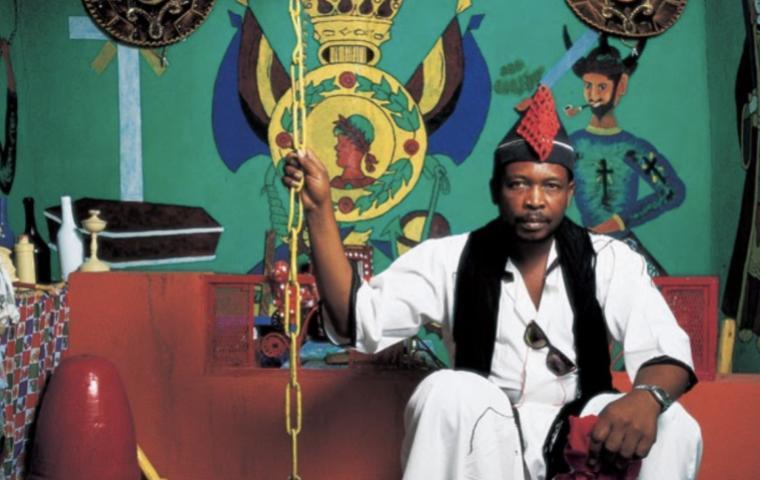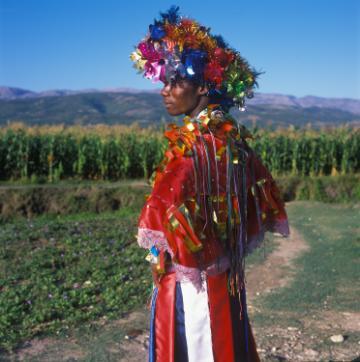
A Potent Brew: Haiti, Vodou, and the U.S. Marines
SCU bioengineering major Bridget Woody '20, delves into brutal history of imperialism in Haiti that offers lessons for today.
It’s the kind of story, says Santa Clara University bioengineering major Bridget Woody ’20, that could be pulled from current headlines: a country in chaos, reeling from a power vacuum, threatens an imperial nation. A military colossus seizes its chance, moves in to “secure peace,” leaving tragedy in its wake.
Such was the backdrop for the U.S. Marines’ occupation of Haiti from 1915-1934. Add in racism and xenophobia—or more specifically, a fear of vodou, the Afro-Creole religion of Haiti—together with a hapless American plan to eradicate those beliefs, and you have the theme of her 2018 honors paper, “The American Crusades: Exploring the Impact of Marine Persecution of Vodou in U.S. Occupied Haiti,” published in SCU’s Historical Perspectives.
“When it comes to human nature, if someone tries to prevent you from practicing one of your central beliefs, people don’t like that,” says Woody, a history minor who researched the invasion. “And that is still relevant today.”
An awakening at SCU
What inspired the 21-year-old SCU Dean’s Scholar and bioengineering major planning on a career in the medical device industry to pursue a course that introduced her to the tyranny of imperialism?

Bridget Woody
A variety of interests, she says, including a love of writing, a lifelong interest in history, and Santa Clara’s flexible core curriculum—a series of required courses that directs students toward an informed ethical engagement with the world.
“A lot of themes in my first religious class and Cultures & Ideas courses were stories about different global communities, and seeing imperialism in my history classes really affected me,” recalls the Wisconsin native, who is interning at a healthcare company that creates minimally-invasive solutions for uterine fibroids.
“Even though I’m not religious, I like the Jesuit values of community and kind of being witness to everyone around you, whether in your immediate community, or distant.”
As a history minor, Woody also enjoyed the fact that she could explore an eclectic range of topics in the department.
“I could go take whatever classes I was interested in,” she says, “and I really enjoyed the aspect of social history.”
For instance, the American Revolution “was not just about George Washington and crossing the Delaware River,” she says. “I learned to focus on the social history in college, like what happened to women and minorities, not just the soldiers or the major players.”
Intrigued by South American and Caribbean history and a course that was narrowly focused on one event in time, Woody enrolled in the Haitian Revolution of 1791-1804, taught by associate professor of history Naomi Andrews.
Central to Woody's interests was how the U.S. and Europe have often used their power to meddle around the globe. Woody’s final assignment was to write a research paper within the scope of what she had learned in Andrews’ class, from the devastating price weaker nations often pay, to the brutal toll of slavery and human suffering.
“The main theme I wanted to convey was kind of how ruthless the U.S. occupiers were in what was their self-proclaimed ‘civilized mission,’” Woody says about her paper. "I think we see that a lot in imperialism—occupying forces attempting to pressure people under the name of civility. I wanted to challenge the idea of what that (civility) is,” says Woody.

Man dressed in costume for the Haitian vodou festival, Rara. Photo courtesy of Haiti ©Phyllis Galembo.
Researching the background for her paper and having to synthesize it was challenging, Woody says. But the process taught her how to use databases and organize her thoughts, something she found invaluable for her other classes at Santa Clara.
It also partly guided her recent application for a Fulbright Scholarship—she is now a semifinalist—and if awarded a Fulbright, Woody hopes to travel to Jamaica to study how technology and new agricultural methods introduced during Britain’s rule of the country influenced the lives of slaves.
“The Haitian Revolution was a very bloody and ongoing 12-year conflict involving the French forces who wanted to hold onto their very profitable sugar and coffee resources,” explains Woody.
“What really stands out to me is that at the time, it was seen as a crazy act of revolution against imperial overlords. But from a modern perspective, it’s a completely justified revolt by the oppressed.”
Fact versus fiction
The U.S. maintained that its occupation in Haiti was about keeping peace in the Western Hemisphere, says Woody. After more than a century of self-rule, the country had become politically instable, raising the stakes for American business interests and growing international influence there.
“In a way, it kind of had pre-Cold War vibes, meaning that American forces and the U.S. government were really concerned with “non-American” values, and were fearful of them,” she says.
To help justify the U.S. occupation, the American media stigmatized Haitian vodou as witchcraft, violent and sacrificial. Few Marines bothered to learn that vodou’s core pillars actually rely upon interconnectedness and personal worship.
Often—and incorrectly—interchanged with Louisiana voodoo, Woody says Haitian vodou is descended from diverse religions practiced by multitudes of mostly West Africans captured during the 17th century slave trade, who were then sent to European colonies in the Caribbean and Brazil.
Yet the U.S. propaganda—with its images of zombies and pins-in-dolls—provoked the U.S. occupiers who feared its use on them. So they routinely destroyed the Haitians’ drums used for vodou’s religious rituals, imprisoned vodou leaders who were often murdered while incarcerated, and beat and tortured Haitian forced laborers “for no reason other than increasing productivity or discouraging unfamiliar worship,” she writes.
But instead of stamping out the rituals and behaviors they found threatening, the Marines achieved the opposite of what they sought, transforming Haitian vodou “from a personal practice into a broader, more subversive form of worship.”
For Woody, the legacies of the 1915-1934 occupation represent the resilience of the Haitian people, rather than the violence of oppression.
“The Haitian Vodouization refused to allow a foreign power to dominate their system of worship,” she concludes, “reclaiming every aspect of appropriation that they could.”
Vodou priest Volny Derosier, seated in his vodou temple in La Petite Rivière de l'Artibonite, Haiti. Photo courtesy of Haiti ©Phyllis Galembo.